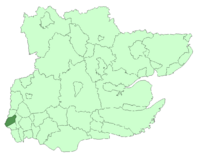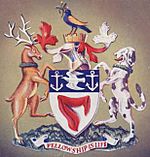Municipal Borough of Walthamstow facts for kids
| Walthamstow | |
| Motto: Fellowship is life | |
 |
|
 |
|
| Geography | |
| Status | Local board district (1873–1894) Urban district (1894–1929) Municipal borough (1929–1965) |
| 1911 area | 4,343 acres (17.58 km2) |
| 1931/1961 area | 4,342 acres (17.57 km2) |
| HQ | Town Hall, Orford Road (1876–1941) Town Hall, Forest Road (1941–1965) |
| History | |
| Origin | Walthamstow ancient parish (excluding Walthamstow Slip) |
| Created | 1873 |
| Abolished | 1965 |
| Succeeded by | London Borough of Waltham Forest |
Quick facts for kids Demography |
|
|---|---|
| 1911 population - 1911 density |
124,580 28.7/acre |
| 1931 population - 1931 density |
132,972 30.7/acre |
| 1961 population - 1961 density |
108,845 25.1/acre |
| Politics | |
| Governance | Walthamstow Local Board (1873–1894) Walthamstow Urban District Council (1894–1929) Walthamstow Borough Council (1929–1965) |
 |
|
Walthamstow was a local government area in southwest Essex, England. It existed from 1873 to 1965. This area was centered around the town of Walthamstow. It was considered part of the London postal district and the area covered by the Metropolitan Police District. Today, the former area of Walthamstow is the central part of the London Borough of Waltham Forest in Greater London.
Contents
How Walthamstow's Local Government Started
The old area of Walthamstow was part of the Becontree hundred in Essex. A "hundred" was a historical division of a county. In 1837, Walthamstow joined the West Ham "poor law union," which managed support for people in need. By 1840, it became part of the Metropolitan Police District, meaning it was policed by London's police force.
In 1873, Walthamstow decided to manage its own local services. It became a "local board district." This meant a group of local people, called a "local board," took charge. They handled things like sanitation and public health. This board replaced the older "vestry" system, which was run by the church. In 1894, this local board district changed again. It became an "urban district," governed by the Walthamstow Urban District Council. This council was responsible for many local services.
Walthamstow's Geography
The original area of Walthamstow included a small, separate piece of land. This piece, called "Walthamstow Slip," was 98 acres and located within Leyton. In 1873, when Leyton also formed its own local government district, Walthamstow Slip became part of it. By December 1, 1877, it officially merged with the Leyton area.
Becoming a Borough
People started talking about Walthamstow becoming a "municipal borough" in 1892. A municipal borough is a town with its own special local government powers. By 1891, Walthamstow had a population of 46,346 people.
Later, in 1907 and 1908, the Walthamstow Urban District Council thought about joining the County of London. If this happened, Walthamstow would have become a "metropolitan borough." By 1911, the population had grown to 124,580.
After the First World War, a local newspaper, the Walthamstow Guardian, pushed for the area to become a borough. A request was sent in 1920. However, the decision was delayed until 1926. This was because a special group, the Royal Commission on London Government, was looking into how London was governed.
The council had been providing electricity to the area since 1895. During a big strike in 1926, the council stopped the electricity supply to factories. After the strike, the council was found to have not done its duty. This caused another delay. Finally, in 1929, Walthamstow was officially granted "borough status." The document making it a borough was given by James Henry Thomas. The first mayor of Walthamstow was Sir Courtenay Warner.
Local Services and Buildings
From 1870 to 1896, there was a "burial board" in Walthamstow. This board managed local cemeteries. In 1896, its duties were taken over by the Walthamstow Urban District Council.
From 1880 to 1903, the Walthamstow School Board was in charge of elementary education. After the Education Act 1902, this power moved to Essex County Council. However, because Walthamstow had a large population, it was allowed to keep control of its own elementary schools. This continued even after the Education Act 1944.
The borough also ran its own tram services. These trams helped people get around Walthamstow. In 1933, the London Passenger Transport Board took over these services.
The first Walthamstow Town Hall was built on Orford Road in 1876. A new and bigger Town Hall was built on Forest Road in 1941. This new building served as the main office for the local government.
The End of Walthamstow Borough
Walthamstow was part of a big review of local government in London. This review was done by the Royal Commission on Local Government in Greater London. The commission suggested that Walthamstow should join with Chingford. They would form one of 52 new boroughs in Greater London.
Because of the London Government Act 1963, the borough of Walthamstow was officially ended in 1965. It was moved from Essex to Greater London. Walthamstow then joined with the former boroughs of Chingford and Leyton. Together, they formed the London Borough of Waltham Forest, which is one of the 32 boroughs in London today.

